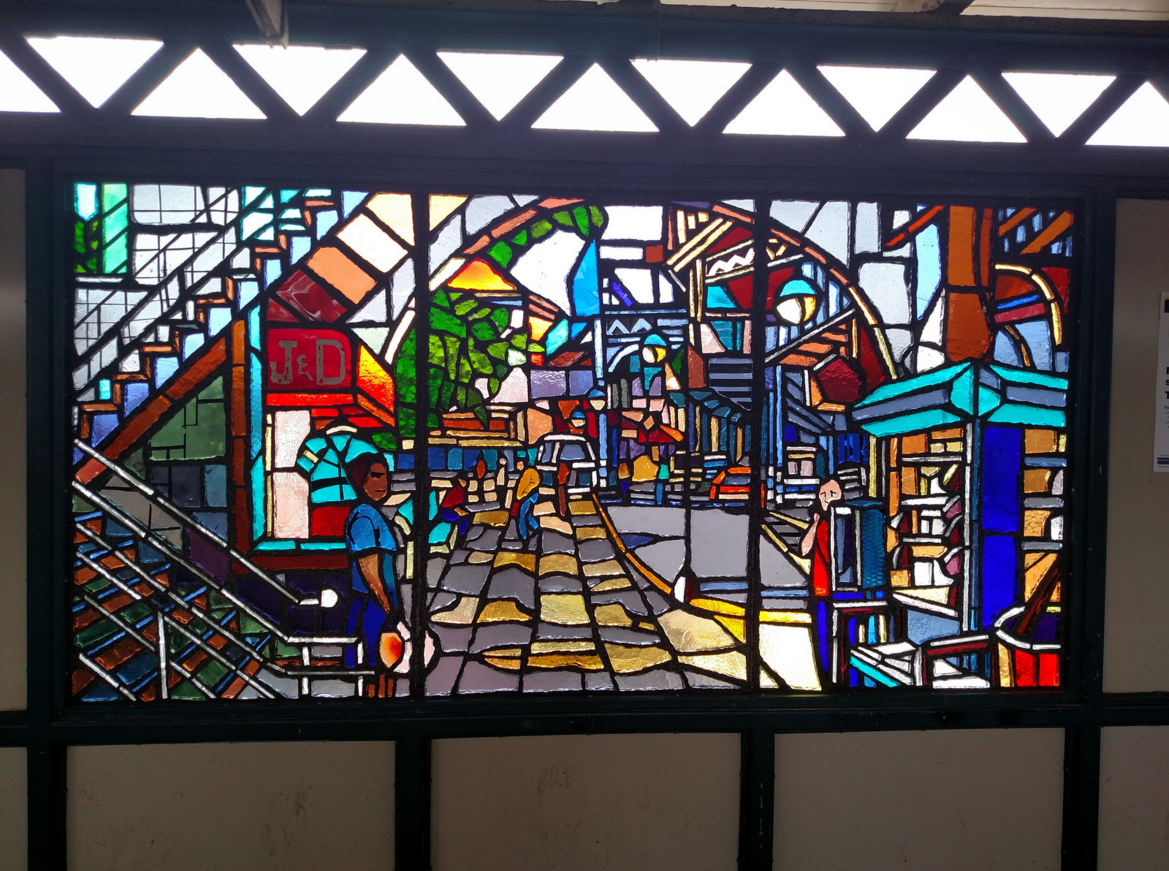Cheat sheet: Six ways to hack the NYC subway system
New Yorkers have no shortage of things to bemoan about their subway: The century-old system has more stations than any other in the world and, according to the MTA, last year’s average daily ridership was 5.7 million people, the highest in decades. All this can add up to overcrowding, delays, and service changes, the kind of barely-controlled chaos that can overwhelm even the most seasoned city dwellers.
At the same time, the system is a marvel; according to Thrillist, if you laid its 660 miles of track from end to end, it would stretch all the way to Chicago. And, for the same price (unlike subways in many other cities), you can go from the farthest corner of the Bronx all the way to Brooklyn. Love it or hate it, the subway is an essential piece of infrastructure that keeps the city running. But there are ways to hack it for a smoother, safer, and more entertaining experience, whether you're a newcomer to New York, or an old-timer with a still-ornery commute.
1. Use apps to navigate
We all think we know more than we do—we are, after all, New Yorkers—but if you haven't yet downloaded a subway smartphone app, you best do so stat. Apps like KickMap provide directions, plus transit alerts if there are service changes, and Google Maps is easy to use—and free—if somewhat less comprehensive.
And if like most New Yorkers you’re really in a rush, Exit Strategy tells you where to best board and get off the train, as well as which station exit to use, depending on your destination. This wisdom has traditionally been hard-won, acquired over many draining commutes and wrong turns inside massive stations—but no one needs to know that you took a shortcut.

2. Ask a conductor (and pick the right entrance)
If you’re totally baffled, ask a train conductor for help. But how to find one quick when the subway cars pull in? Here's one awesome trick we learned (and we've been here a long time): Find the black-and-white board that hangs over the middle of the platform and position yourself under it. Conductors use these boards to make sure the train is aligned properly in the station, and their cars always stop in front of them, so you’ll be ready to ask a quick question before the train has to move on.
Note to newbies to the city: Once you’re on the street searching for a station, look out for the green globes that mark entrances—and when you find them, make sure you know whether you’re headed uptown or downtown, as entrances can vary depending on which direction the trains run. Be mindful, too, of express and local trains, to avoid overshooting your stop or taking longer to get there than necessary.
3. Mind your MetroCard math
Use the MTA’s calculator to figure out how to get a zero balance, rather than end up with odd dollars and cents left over. Remember that you have two hours after a swipe to transfer to buses for free. And be prepared to eventually bid farewell to the MetroCard, as the city plans to phase them out by 2018. And it goes without saying that you should never throw away a card, because you’ll have to pay another $1 surcharge the next time you purchase one.
4. Prepare for delays and service changes
New York magazine recently chronicled a particularly nightmarish day on the subway, when a chain reaction of problems added up to 625 delays throughout the system. Sometimes, issues like these are unavoidable—oh, the pain of hearing that tinny, recorded refrain of “We are being held because of train traffic ahead of us”—but often, you can arm yourself against subway troubles.
Before you head out to Sunday brunch, check The Weekender to find out if there have been any changes along your line. (Fun fact: the Weekender uses a subway map designed by Massimo Vignelli, a designer whose diagrammatic guide to the system aroused plenty of controversy when it was introduced in 1972, according to the New York Times.)
You can also follow the MTA on Twitter for real time service updates, or turn to SubwayStats for the non-establishment perspective.

5. Stay safe
We’re a long way from the subway’s years of struggle, when ridership plummeted as crime became rife on the trains during the 1970s and 80s. Generally speaking, the subway is a much safer place to be these days, though as NBC reports, violent crime is up compared to last year.
In another article, NBC lays out some techniques for protecting yourself from thieves, which include moving away from someone who is crowding you, keeping bags zipped and phones out of sight, and staying alert. The NYPD also advises waiting at a station’s off-hours waiting area--this varies by station, but is typically by the station agent's booth--and riding in the train’s conductor’s car, if you’re traveling alone late at night. And there are times it might be best to avoid the subway entirely, in which case ride share services like UberPOOL are a relatively affordable alternative. And for women and gender-nonconforming people, RightRides is a non-profit organization that provides free, late-night rides home to insure safety.
Another aspect of self-protection involves being attuned to your fellow passengers’ behavior and body language. Stay aware of your surroundings—this might mean losing the headphones—and if someone strikes you as erratic or threatening, try to move to a different car, or simply get off the train. Many subway stations now have "Help Points," which allow passengers to call in emergencies and ask for help.

6. Entertain yourself
Believe it or not, the subway can be fun: There are genuine works of public art scattered throughout the system to track down and experience. This subway art guide provides an exhaustive overview of the murals, stained glass pieces, and sculptures you can find at different stations. One work is only visible from the train: the Masstransicope presents a moving picture to straphangers through the windows of the express as it leaves DeKalb Avenue. And the Herald Square station features interactive audio art on its NQR platforms.
Entertainment can also come in the form of views: when the 7 train goes above ground in Queens, for instance, you’ll see why the line has been dubbed “the International Express” as it passes through the borough’s ethnic enclaves, ultimately gliding by Citi Field and Arthur Ashe Stadium before terminating in Flushing. And the B, D, N, and Q trains all travel between Manhattan and Brooklyn by way of the Manhattan Bridge, offering stunning perspectives of the city skyline.
Many urban explorers have made it their mission to catch a glimpse of the city’s abandoned subway stations, some of which are visible on other journeys between stations, per Untapped Cities. And for the true aspiring subway buff, a trip to the Transit Museum is essential.
Finally, some closing words of wisdom from real estate brokers and longtime New Yorkers who have made their subway commutes that much more efficient:
• “The entire subway map is already on the Apple maps app on your phone (if you have an iPhone). All you have to do is click the ‘i’ button in the bottom right hand corner and select ‘transit.’ From there, you can click on the subway line or station to find which trains stop where. It’s a way to learn where and how to transfer trains.” –Max Levine, Citi Habitats
• “Install the NY Times app on your phone and update it before you get on, in case the train is too crowded to physically read the paper.” –James, Astoria
• “When heading downtown on the 1 train, you should be in the first five cars if you are getting off at South Ferry. These are the only ones that open there since Hurricane Sandy. If you're not getting off at South Ferry, sit in cars 6 through 10 to get a seat. And from Rector Street north, stay towards the back of the train as the first five cars are full from the ferry.” –James C. Cox Jr., Compass
• “My tip for newbies is to step aside and get out of the way! Step to the right when using an escalator if you are not walking to let others pass. When you get to the top or bottom, step aside. It’s bad form when people reach the top of the escalator and decide to stand there and check their phone.
• Step into the middle of the train car when entering so you are not blocking or getting mowed down when the doors open. On the platform step behind a pillar, or at the end of a bench to block the swarm of people from jostling you.” –Brucha Losick, Citi Habitats
• “On the 7 line in the morning, if you don't have a seat, stand by or near the teens wearing backpacks. Between Aviation High School at 40th Street and Laguardia Community College at 33rd Street, you're bound to be sitting pretty by Queensboro Plaza.” –Jeanette, Sunnyside
• “If you hold your MetroCard so that it bends slightly towards you as you run it through the turnstile it helps the strip connect and eliminates all those mis-swipes and bruised hips from walking into the locked turnstile bars.” –Beck Hickey, Citi Habitats
You Might Also Like




























